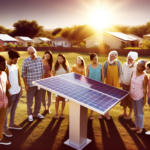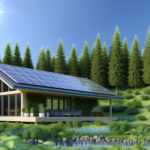Introduction
The Rise of Solar Power in Outdoor Exploration
In recent years, solar power has emerged as a game-changer in the realm of outdoor exploration. As technology advances, solar panels have become more efficient, portable, and affordable, making them an ideal power source for adventurers. From mountaineers scaling the highest peaks to campers enjoying a weekend in the woods, solar power is increasingly being used to keep devices charged, provide lighting, and even cook meals. This shift towards solar energy is not just a trend but a significant movement towards sustainable and self-sufficient exploration.
Why Solar Power Appeals to the Modern Explorer
The modern explorer is often characterized by a deep appreciation for nature and a commitment to preserving it. Solar power aligns perfectly with these values, offering a clean and renewable energy source that minimizes environmental impact. Here are a few reasons why solar power is particularly appealing:
- Eco-Friendly: Solar power reduces reliance on fossil fuels, decreasing carbon footprints and promoting environmental sustainability.
- Cost-Effective: After the initial investment, solar energy is free, reducing the need for expensive and heavy batteries.
- Reliability: Solar panels can generate power as long as there is sunlight, making them a reliable source of energy in remote locations.
- Portability: Modern solar panels are lightweight and compact, making them easy to carry on any adventure.
Purpose of the Article
This article aims to empower outdoor enthusiasts by providing comprehensive information on educational tools and resources related to solar power. Whether you are a seasoned explorer or a novice adventurer, understanding how to harness solar energy can significantly enhance your outdoor experiences. We will cover the basics of solar power, introduce essential solar-powered tools, and highlight educational resources to deepen your knowledge. Additionally, we will offer practical tips for maximizing solar power efficiency and share inspiring case studies of real-life solar-powered explorers. By the end of this article, you will be well-equipped to integrate solar power into your adventures, promoting both sustainability and self-sufficiency.
Understanding Solar Power Basics
How Solar Panels Work
Solar panels, also known as photovoltaic (PV) panels, convert sunlight into electricity. They are composed of many solar cells made from silicon semiconductors. When sunlight hits these cells, it excites electrons, creating an electric current. This process is known as the photovoltaic effect. The generated direct current (DC) electricity is then converted into alternating current (AC) by an inverter, making it usable for most electrical devices.
Types of Solar Panels
There are several types of solar panels, each with its own advantages and applications:
- Monocrystalline Panels: Made from a single continuous crystal structure, these panels are highly efficient and space-efficient but tend to be more expensive.
- Polycrystalline Panels: Composed of multiple silicon crystals, these panels are less efficient than monocrystalline but are more affordable.
- Thin-Film Panels: These are made by depositing one or more layers of photovoltaic material onto a substrate. They are flexible and lightweight but generally less efficient than crystalline panels.
Key Components of a Solar Power System
A complete solar power system includes several key components:
- Solar Panels: Capture sunlight and convert it into electricity.
- Inverter: Converts DC electricity from the panels into AC electricity for use in homes and devices.
- Battery Storage: Stores excess energy for use during cloudy days or at night.
- Charge Controller: Regulates the voltage and current coming from the solar panels to prevent overcharging the batteries.
- Mounting System: Secures the solar panels to rooftops or the ground.
Benefits of Using Solar Power
Solar power offers numerous benefits, making it an attractive option for modern explorers:
- Renewable and Sustainable: Solar energy is inexhaustible and reduces reliance on finite fossil fuels.
- Environmentally Friendly: Solar power generation produces no greenhouse gases or pollutants, contributing to a cleaner environment.
- Cost-Effective: While the initial setup can be expensive, solar power can significantly reduce or even eliminate electricity bills over time.
- Energy Independence: Solar power allows individuals to generate their own electricity, reducing dependence on the grid.
- Low Maintenance: Solar power systems require minimal maintenance, with most panels having a lifespan of 25-30 years.
By understanding these basics, explorers can make informed decisions about integrating solar power into their adventures, ensuring they harness the sun’s energy effectively and sustainably.
Essential Solar-Powered Tools for Explorers
Portable Solar Chargers
Portable solar chargers are indispensable for modern explorers who rely on electronic devices for navigation, communication, and documentation. These chargers harness sunlight to generate electricity, providing a renewable and eco-friendly power source. **Key features** to look for include high-efficiency solar panels, multiple USB ports, and a durable, weather-resistant design. Some advanced models even come with built-in batteries to store energy for use during cloudy days or nighttime. *Popular brands* like Goal Zero and Anker offer a range of options suitable for various needs and budgets.
Solar-Powered Lights and Lanterns
Lighting is crucial for safety and convenience during outdoor adventures. Solar-powered lights and lanterns offer a sustainable solution, eliminating the need for disposable batteries. These devices typically feature **LED bulbs**, which are energy-efficient and long-lasting. Many models are designed to be compact and lightweight, making them easy to pack and carry. Some lanterns also double as flashlights or have adjustable brightness settings. *Brands like MPOWERD and BioLite* are well-regarded for their innovative and reliable solar lighting solutions.
Solar-Powered Cooking Devices
For those who enjoy cooking in the great outdoors, solar-powered cooking devices are a game-changer. These devices use reflective surfaces to concentrate sunlight, generating heat for cooking. **Solar ovens** and **solar cookers** can bake, boil, and steam food without the need for fuel or electricity. They are particularly useful in remote areas where traditional cooking methods may be impractical. *Notable products* include the GoSun Solar Oven, which is known for its portability and efficiency, and the Solavore Sport Solar Oven, which offers a larger cooking capacity.
Solar-Powered Communication Devices
Staying connected is essential for safety and coordination during expeditions. Solar-powered communication devices, such as satellite phones and two-way radios, ensure that explorers can maintain contact even in remote locations. These devices often come with **integrated solar panels** or can be paired with portable solar chargers. Some models also feature GPS capabilities, providing an added layer of security. *Brands like Garmin and SPOT* offer reliable solar-powered communication tools that are designed to withstand harsh outdoor conditions.
Incorporating these solar-powered tools into your gear not only enhances your outdoor experience but also promotes sustainable and eco-friendly practices. By leveraging the power of the sun, modern explorers can reduce their environmental impact while enjoying the convenience and reliability of renewable energy.
Educational Resources for Solar Power Enthusiasts
Online Courses and Tutorials
For those eager to dive into the world of solar power, online courses and tutorials offer a flexible and comprehensive way to learn. Websites like Coursera, Udemy, and edX provide a range of courses that cover everything from the basics of solar energy to advanced system design and installation. These courses often include video lectures, interactive quizzes, and hands-on projects to solidify your understanding. Additionally, platforms like YouTube host numerous channels dedicated to solar power, offering free tutorials and practical tips.
Books and Guides
Books and guides are invaluable resources for anyone looking to deepen their knowledge of solar power. Titles such as *”Solar Power for Beginners: How to Design and Install the Best Solar Power System for Your Home”* by Paul Holmes and *”The Solar Electricity Handbook”* by Michael Boxwell provide step-by-step instructions and detailed explanations. These books cover a wide range of topics, including system design, installation, and maintenance, making them perfect for both novices and experienced enthusiasts.
Workshops and Community Events
Attending workshops and community events can provide hands-on experience and the opportunity to network with other solar power enthusiasts. Many local community centers, environmental organizations, and educational institutions offer workshops on solar power installation and maintenance. These events often feature expert speakers, live demonstrations, and Q&A sessions, providing a rich learning experience. Additionally, solar expos and trade shows are excellent venues to see the latest technology and innovations in the field.
Online Forums and Communities
Online forums and communities are great places to connect with other solar power enthusiasts, share experiences, and seek advice. Websites like SolarPanelTalk, Reddit’s r/solar, and the DIY Solar Power Forum offer vibrant communities where members discuss everything from troubleshooting issues to sharing success stories. These platforms provide a wealth of user-generated content, including detailed guides, product reviews, and real-world case studies, making them invaluable resources for anyone interested in solar power.
By leveraging these educational resources, solar power enthusiasts can gain the knowledge and skills needed to effectively harness the power of the sun, whether for personal use or professional endeavors.
Tips for Maximizing Solar Power Efficiency
Optimal Placement and Angle of Solar Panels
To maximize the efficiency of your solar panels, it is crucial to place them in an optimal location and at the correct angle. **Solar panels should be positioned in an area that receives maximum sunlight throughout the day**. This typically means avoiding shaded areas caused by trees, buildings, or other obstructions. The angle of the panels should be adjusted according to your geographical location. For instance, in the Northern Hemisphere, panels should generally face south and be tilted at an angle equal to the latitude of your location. This ensures that the panels capture the most sunlight possible, especially during peak sun hours.
Maintaining and Cleaning Solar Panels
Regular maintenance and cleaning are essential for keeping your solar panels operating at peak efficiency. **Dust, dirt, and debris can accumulate on the surface of the panels, reducing their ability to absorb sunlight**. It is recommended to clean the panels at least twice a year, or more frequently if you live in a particularly dusty or pollen-heavy area. Use a soft brush or a squeegee with a gentle soap solution to clean the panels. Avoid using abrasive materials or harsh chemicals, as these can damage the surface of the panels.
Energy Storage Solutions
Effective energy storage solutions are vital for ensuring a consistent power supply, especially during cloudy days or nighttime. **Battery storage systems can store excess energy generated during sunny periods for use when sunlight is not available**. Lithium-ion batteries are a popular choice due to their high energy density and long lifespan. Additionally, integrating a smart energy management system can help you monitor and optimize energy usage, ensuring that stored energy is used efficiently.
Weather Considerations
Weather conditions can significantly impact the performance of your solar power system. **Cloud cover, rain, and snow can reduce the amount of sunlight reaching your panels, thereby decreasing energy production**. To mitigate these effects, consider installing a weather monitoring system that can provide real-time data on weather conditions and adjust the energy management system accordingly. In snowy regions, ensure that the panels are installed at an angle that allows snow to slide off easily, preventing accumulation that can block sunlight.
By following these tips, you can maximize the efficiency of your solar power system, ensuring a reliable and sustainable energy source for your outdoor explorations.
Case Studies: Real-Life Solar-Powered Explorers
Off-Grid Living Success Stories
Living off the grid has become a viable and attractive option for many modern explorers, thanks to advancements in solar technology. One notable example is the story of the Johnson family, who decided to leave their urban lifestyle behind and move to a remote cabin in the Rocky Mountains. Equipped with a robust solar power system, they have managed to sustain their household entirely on renewable energy. Their setup includes high-efficiency solar panels, a battery storage system, and an inverter to convert the stored energy into usable electricity. This system powers everything from their lighting and heating to their communication devices and kitchen appliances. The Johnsons have not only reduced their carbon footprint but also gained a profound sense of independence and self-sufficiency.
Adventurers Using Solar Power
Solar power has also revolutionized the way adventurers explore the great outdoors. Take, for instance, the case of Sarah Thompson, a solo hiker who completed the Pacific Crest Trail using solar-powered gear. Sarah’s backpack was equipped with a lightweight, foldable solar panel that charged her GPS device, smartphone, and headlamp. This allowed her to navigate, communicate, and stay safe without the need for disposable batteries or frequent stops to recharge. Similarly, the adventurer duo, Mark and Lisa, used solar power to fuel their kayaking expedition across the Amazon River. They relied on solar-powered water purifiers and communication devices, which were crucial for their survival and coordination in the remote wilderness.
Lessons Learned from Experienced Users
Experienced users of solar power in outdoor settings have shared invaluable lessons that can benefit aspiring solar-powered explorers. One key takeaway is the importance of understanding the limitations and capabilities of your solar equipment. For instance, solar panels are most effective when placed at the optimal angle and in direct sunlight. Users like Sarah Thompson emphasize the need for regular maintenance, such as cleaning the panels to remove dust and debris, which can significantly impact efficiency.
Another lesson is the importance of energy storage solutions. The Johnson family found that investing in high-quality batteries was crucial for storing excess energy generated during sunny days, ensuring a reliable power supply during cloudy periods or at night. Mark and Lisa’s experience highlights the need for redundancy; they carried backup solar chargers and extra batteries to mitigate the risk of equipment failure.
Lastly, weather considerations play a significant role in the effectiveness of solar power. Experienced users recommend planning for weather variability by incorporating hybrid systems that can switch to alternative power sources when solar energy is insufficient. This approach ensures a continuous power supply, enhancing the overall reliability of the solar-powered setup.
In summary, these real-life case studies demonstrate the transformative potential of solar power for off-grid living and adventurous exploration. By learning from the experiences of seasoned users, new explorers can better prepare themselves to harness the full benefits of solar technology, making their journeys more sustainable and self-reliant.
Conclusion
The Future of Solar Power in Outdoor Exploration
The future of solar power in outdoor exploration is incredibly promising. As technology continues to advance, solar panels are becoming more efficient, lighter, and more affordable. This evolution is making it easier for explorers to harness the sun’s energy, even in the most remote locations. Innovations such as flexible solar panels and integrated solar fabrics are on the horizon, potentially revolutionizing how we think about portable power. These advancements will not only enhance the capabilities of modern explorers but also make solar power an indispensable tool for anyone venturing into the great outdoors.
Encouraging Sustainable Practices
Adopting solar power is more than just a practical choice; it’s a commitment to sustainability. By using solar-powered tools and devices, explorers can significantly reduce their carbon footprint. This shift towards renewable energy sources helps preserve the natural environments that adventurers cherish. Moreover, promoting the use of solar power in outdoor activities can inspire others to consider sustainable practices in their daily lives. Whether it’s through educational workshops, community events, or simply leading by example, every effort counts in fostering a culture of environmental responsibility.
Final Thoughts and Call to Action
In conclusion, the integration of solar power into outdoor exploration is not just a trend but a transformative movement. It offers a sustainable, reliable, and efficient way to power your adventures, ensuring that you can explore further and stay connected without compromising the environment. As we look to the future, it’s clear that solar power will play a pivotal role in shaping the way we interact with the natural world.
**Call to Action:** If you’re passionate about outdoor exploration and committed to sustainability, now is the time to invest in solar-powered tools and educational resources. Equip yourself with the knowledge and technology to make your adventures not only thrilling but also eco-friendly. Join the community of solar-powered explorers and be a part of the movement towards a greener, more sustainable future.






